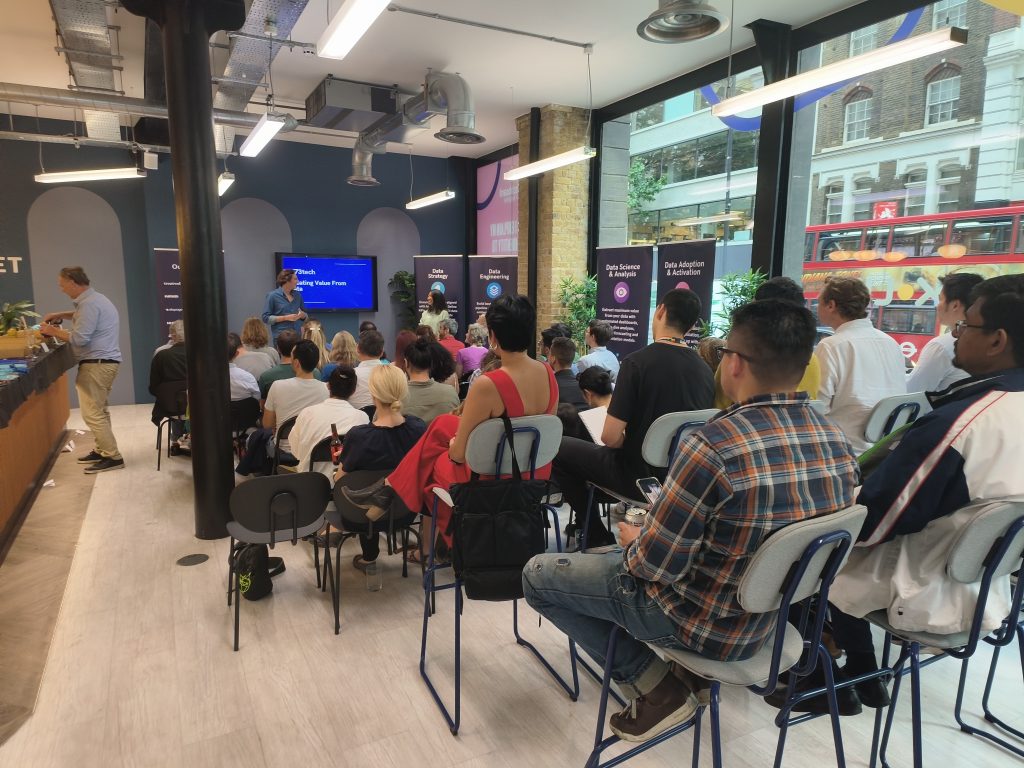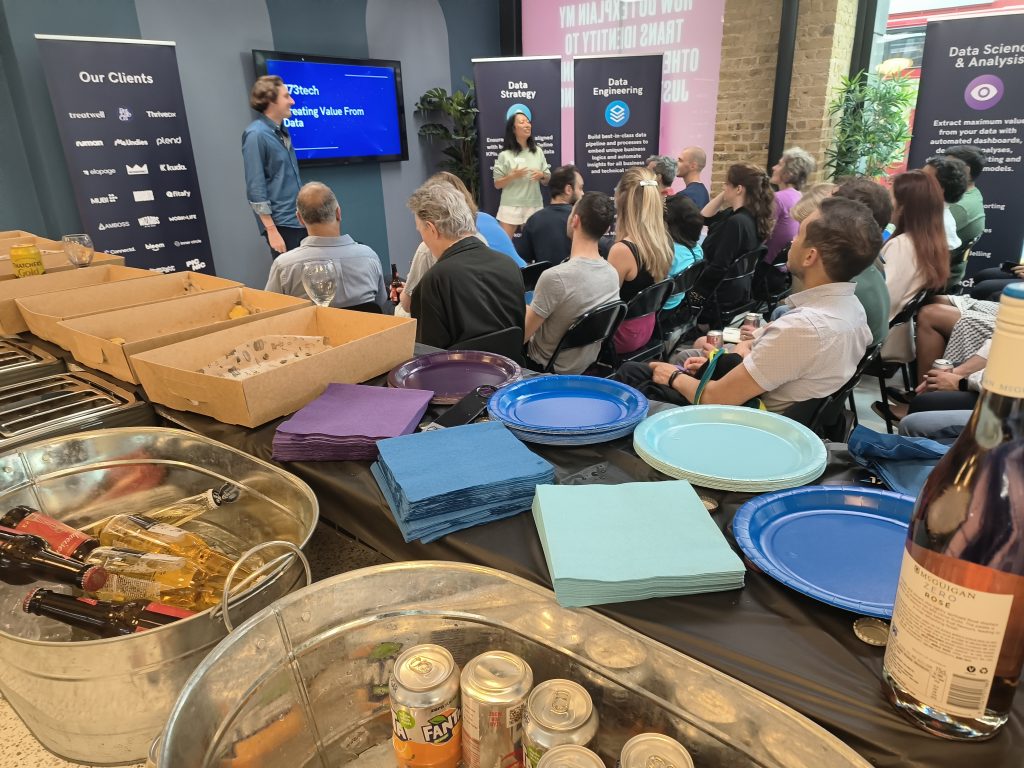Creating Value From Data
Data is one of the few investments that can generate unlimited ROI. Yet businesses of all sizes find it challenging to unlock the full value of data. We share our expertise…





What A Great Event!
Thanks so much for everyone for joining us at our first-ever live event. It was great to see so many familiar faces, valued clients and key partners all together in one room and to meet so many of you in person for the first time.
We hope you enjoyed the event, met some new people, learnt some new things and ate some good food. Below we have summarised some key learnings from our presentation. If you’d like to find out more why not book a call?
Analytics Journey
173tech helps clients on every step of their analytics journey. Below we’ve summarised the different stages of data maturity. Click on any symbol to find out more.
Define Strategy
We often say that good data should align with your business strategy and goals. Easy to say, but harder to achieve. Start with the core data source (e.g. your operational database) and key business questions and expand your efforts from there. Consider not only what the problem is, but the decisions you can make to affect it and the data that can then inform that decision.
- What are your key business problems?
- What decisions do you want to inform?
- Have you defined your KPIs?
- Define life stages for the journey.
- Evaluate customer channels.
- Identify which data points are collected.
- Map out tool stack.
- Identify high ROI case studies.
- Iterate and grow your data efforts.
Automate Core Reporting
A modern data pipeline comprises of a number of different tools all working in harmony. While there are a lot of reporting tools out there, by centralising your data you can The setup we will recommend will vary depending on your data sources, volumes and level of maturity. Here’s a quick overview.






'Quick Wins' Analysis
With your data foundations set up, align your next data project with the function that will benefit the most. Look for areas of your business with high expenditure where a more data-driven approach could yield significant results. Here are a few good places to start.
Create one version of the truth by extracting data from across your operational, marketing, and finance platforms into your data warehouse. Model it into your unique business metrics allowing you to create bespoke reports, compare like-for-like and optimise what’s truly important to you as a business. Save time and effort manually pulling together reports and create what we call a 'master dashboard' a top-level overview on the core business metrics on a regular basis. We often refer to this as being a "five minute health check."
Understanding and optimising LTV allows businesses to make informed decisions about customer acquisition, retention, and overall marketing strategies. Once you have a data model for LTV, you can later use this as the base for predictive modelling so that when a new customer interacts with you, you can estimate their value from day one.
Marketing platforms are greedy and often claim credit for the same lead, with a heavy weighting towards Google. Ensure you are only paying once for conversions, no matter the customer's journey by centralising marketing spend, integrating ad spend from different channels and de-duplicating conversions. Clients typically save a minimum of 20% on their paid media spend just through this.
In-Depth Analysis
With your first wins under your belt, your organisation will be excited about the possibilities that data can bring. Now it’s time to deep-dive into your data to discover hidden levers that drive the most value for the business at every step of the customer journey. Here’s a few example






Democratisation
“Helping us make better decisions” is a slogan, not a good way to evaluate and progress your data initiatives. There is little value from a data solution that is not being used by your teams and so democratisation is absolutely crucial.
Make it as simple as possible.
Interactive sessions - not presentations.
Leverage data champions.
- Get stakeholders onboard with a data-driven approach.
- Build processes around data.
- Prioritise trust.
- Map out tool stack.
- Identify high ROI case studies.
- Iterate and grow your data efforts.
Activation
Customer data is invaluable for understanding customer behaviour, preferences and needs. How do you ensure that this data does not sit in a silo or is only accessible to data people? Data activation is the process of sending modelled data insights back into your systems and third-party tools. This could be flagging clients with high propensity to churn and sending it automatically to Salesforce.
Predictive Modelling
Predictive modelling looks at the past behaviour and characteristics of your customers to make predictions about their future actions. It can act as a guiding light, illuminating the right decision when your brand wants to understand which customers are more likely to open an email, buy that product or are at risk of leaving.
Predicted lifetime value looks at the likely value of a single customer throughout their time as your customer. This can be as simple as grouping customers who came from a particular source or bought a particular product and seeing what value they went onto bring, or as complex as applying linear regression or Bayesian probabilistic models to your database to try and determine future value.
This model tells you which customers are more likely to make a purchase based on their past behaviour. It can tell you which customers just need that extra nudge to close the deal, and which should be left alone. Not only can it tell you where to spend money (on advertising or in the form of sales action) it can show you where not to spend money. (Giving customers discounts who are already likely to convert)
This is a way of estimating how much a customer’s category spend is with your brand. So for example if a customer spend £500 a year on clothes, how much of that is with you? Having this information is useful in that it can help to identify the potential future revenue within your existing customer base and allows your marketing team to create campaigns which target this revenue.
In a world where customer privacy is at the forefront of everyone’s minds, brands have never been more scared of turning that corner and becoming a nuisance to the very people they are trying to engage. As such, understanding which people are likely to open email, react to social media or engage with a competition can be extremely useful. You might be familiar with this from online advertising in which your ad is shown to lookalike audiences to the people already visiting your website.
Today’s consumer is more informed, more empowered and can more easily change provider. As such it is critical that brands leverage their first-party data and put a clear emphasis on the retention of customers. You need to understand the motivations behind customers leaving and be able to forecast the impact that different measures would have in reducing this.
Ready To Start Your
Data Engine?
Want to find out what the possibilities are for turning your data into business drivers?
Not sure if your ideas for using data are technically feasible and will generate ROI?
Have a specific use case in mind for your data but don’t know how to get started?
Get in Touch!
Copyright © 2023 173 TECH LTD. All Rights Reserved.


